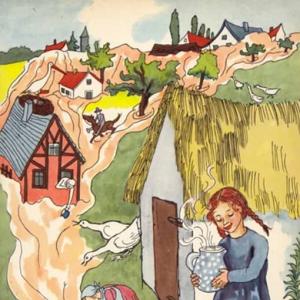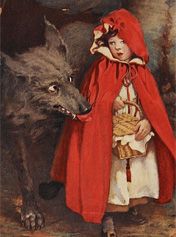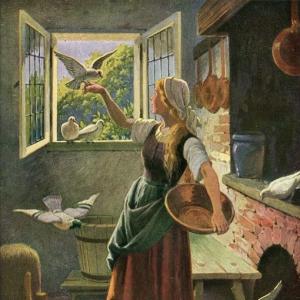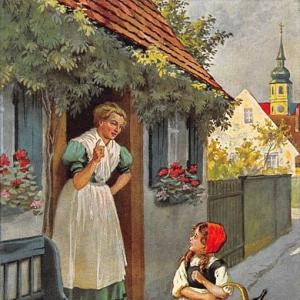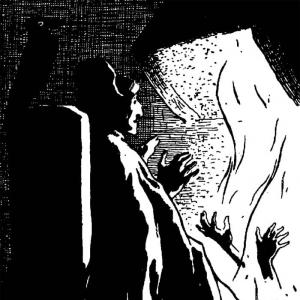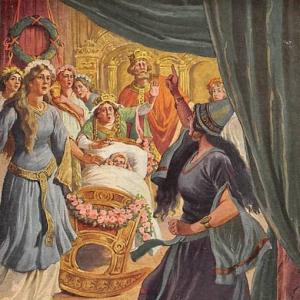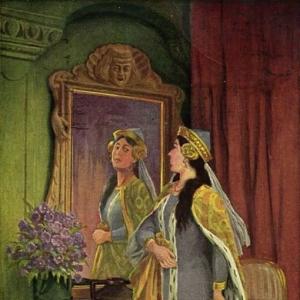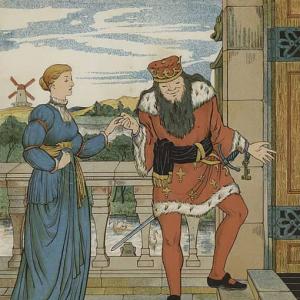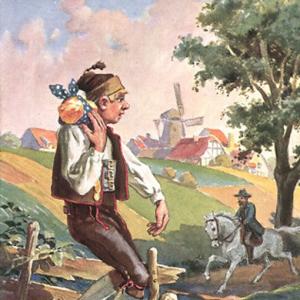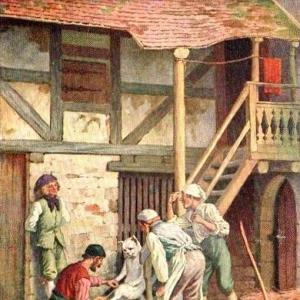Reading time: 5 min
In ancient times a giant was once travelling on a great highway, when suddenly an unknown man sprang up before him, and said, „Halt, not one step farther!“ – „What!“ cried the giant, „a creature whom I can crush between my fingers, wants to block my way? Who art thou that thou darest to speak so boldly?“ – „I am Death,“ answered the other. „No one resists me, and thou also must obey my commands. But the giant refused, and began to struggle with Death. It was a long, violent battle, at last the giant got the upper hand, and struck Death down with his fist, so that he dropped by a stone. The giant went his way, and Death lay there conquered, and so weak that he could not get up again.
„What will be done now,“ said he, „if I stay lying here in a corner? No one will die in the world, and it will get so full of people that they won’t have room to stand beside each other.“ In the meantime a young man came along the road, who was strong and healthy, singing a song, and glancing around on every side. When he saw the half-fainting one, he went compassionately to him, raised him up, poured a strengthening draught out of his flask for him, and waited till he came round. „Dost thou know,“ said the stranger, whilst he was getting up, „who I am, and who it is whom thou hast helped on his legs again?“ – „No,“ answered the youth, „I do not know thee.“ – „I am Death,“ said he. „I spare no one, and can make no exception with thee, but that thou mayst see that I am grateful, I promise thee that I will not fall on thee unexpectedly, but will send my messengers to thee before I come and take thee away.“ – „Well,“ said the youth, „it is something gained that I shall know when thou comest, and at any rate be safe from thee for so long.“
Then he went on his way, and was light-hearted, and enjoyed himself, and lived without thought. But youth and health did not last long, soon came sicknesses and sorrows, which tormented him by day, and took away his rest by night. „Die, I shall not,“ said he to himself, „for Death will send his messengers before that, but I do wish these wretched days of sickness were over.“ As soon as he felt himself well again he began once more to live merrily. Then one day some one tapped him on the shoulder. He looked round, and Death stood behind him, and said, „Follow me, the hour of thy departure from this world has come.“ – „What,“ replied the man, „wilt thou break thy word? Didst thou not promise me that thou wouldst send thy messengers to me before coming thyself? I have seen none!“ – „Silence!“ answered Death. „Have I not sent one messenger to thee after another? Did not fever come and smite thee, and shake thee, and cast thee down? Has dizziness not bewildered thy head? Has not gout twitched thee in all thy limbs? Did not thine ears sing? Did not tooth-ache bite into thy cheeks? Was it not dark before thine eyes? And besides all that, has not my own brother Sleep reminded thee every night of me? Didst thou not lie by night as if thou wert already dead? The man could make no answer. He yielded to his fate, and went away with Death.
 Learn languages. Double-tap on a word.Learn languages in context with Childstories.org and Deepl.com.
Learn languages. Double-tap on a word.Learn languages in context with Childstories.org and Deepl.com.Backgrounds
Interpretations
Adaptions
Summary
Linguistics
„Death’s Messengers“ is a lesser-known fairy tale from the collection of German folklore gathered and published by the Brothers Grimm, Jacob and Wilhelm. The Brothers Grimm were 19th-century linguists, cultural researchers, and scholars who dedicated themselves to preserving and documenting the rich oral storytelling traditions of their time. Their collection of folktales, known as „Grimms‘ Fairy Tales“ or „Children’s and Household Tales“ (Kinder- und Hausmärchen), was first published in 1812 and contains more than 200 stories, including well-known tales such as „Cinderella,“ „Hansel and Gretel,“ and „Snow White.“
„Death’s Messengers“ is a story that focuses on themes of mortality, the inevitability of death, and human suffering. Unlike many other fairy tales that showcase magical elements, enchanted creatures, and fantastical settings, this tale features a more somber and realistic subject matter, addressing the universal themes that are relatable across time and cultures.
While it may not be as famous or widely recognized as other Grimm fairy tales, „Death’s Messengers“ serves as a reminder of the rich diversity of themes and narratives found within their collection. It highlights the Brothers Grimm’s dedication to capturing a broad range of human experiences and emotions in their work.
„Death’s Messengers“ offers several interpretations that can be derived from its narrative:
The inescapability of death: The story serves as a reminder that no matter one’s strength, wealth, or status, death is an unavoidable part of life. The giant, despite his power, is unable to keep death from eventually claiming the young man, reinforcing the idea that death is an equalizer that spares no one.
The value of gratitude and compassion: When the young man helps the weakened Death, he receives a promise in return, demonstrating the significance of kindness and empathy towards others. However, this gratitude should not be taken for granted, as shown by the young man’s eventual encounter with Death.
Recognizing the signs of life’s fragility: The young man fails to recognize the various ailments he suffers as the messengers of Death. This could symbolize the importance of paying attention to life’s hardships and understanding that they are inevitable parts of the human experience, rather than merely brushing them aside.
The deceptive nature of comfort: The young man, believing himself safe from Death, enjoys a carefree life without fear. This story could serve as a warning against becoming too comfortable or complacent in life, as one never knows when their time will come.
The role of suffering in human life: The tale highlights that suffering and ailments are an inherent part of life. These hardships can serve as reminders of our own mortality and the transitory nature of human existence.
The fairy tale „Death’s Messengers“ has inspired various adaptations in different forms of media, including:
Films: The tale has been adapted into several films, including „The 7th Victim“ (1943), a horror film that features a character based on Death; „The Seventh Seal“ (1957), a Swedish film that explores themes of death and mortality; and „Hellboy II: The Golden Army“ (2008), which features a character named Johann Krauss who communicates with the dead.
Literature: „Death’s Messengers“ has inspired several literary works, including „The Book Thief“ (2005) by Markus Zusak, which features Death as a narrator; „The Sandman“ (1989-1996), a comic book series by Neil Gaiman that includes a character named Death; and „Mortal Coil“ (2010), a young adult novel by Derek Landy that features the personification of Death.
Music: The tale has been referenced in several songs, including „Death Is Not the End“ by Bob Dylan, „Grim Goodbye“ by Red Jumpsuit Apparatus, and „Death’s Messengers“ by Ensiferum.
Art: The tale has inspired several works of art, including paintings by artists such as Pieter Bruegel the Elder, Salvador Dali, and Edvard Munch.
Video Games: The story has also inspired various video games, including „Death’s Gambit“ (2018), an action platformer that features Death as a character, and „Grim Fandango“ (1998), an adventure game that takes place in the Land of the Dead.
Overall, the tale of „Death’s Messengers“ has had a significant impact on popular culture and continues to inspire creative works across various forms of media.
„Death’s Messengers“ is a fairy tale by the Brothers Grimm, which tells the story of a giant who encounters Death on a great highway. When Death demands obedience, the giant refuses and a fierce battle ensues. Eventually, the giant defeats Death, leaving him weakened and unable to perform his duties.
Later, a healthy young man discovers the weakened Death and helps him recover. In gratitude, Death promises not to take the man unexpectedly, instead pledging to send messengers before his arrival. The young man continues to live his life without worry, believing he is safe from Death for the time being. However, he soon faces sickness and sorrow, longing for an end to his suffering but believing he will not die since he has not seen any messengers.
One day, Death appears and informs the young man that his time has come. The man protests, claiming he had not received any messengers. Death explains that the man’s various ailments were the messengers, including fever, dizziness, gout, and toothache, among others. Death also reveals that his own brother, Sleep, had reminded the man of him every night. The young man realizes he has no defense and reluctantly follows Death, acknowledging his inevitable fate.
The fairy tale „Death’s Messengers“ by the Brothers Grimm presents an intriguing narrative that can be explored through a linguistic lens to reveal its underlying themes and functions. Here’s a linguistic analysis focusing on key elements such as dialogue, characterization, and metaphor.
Dialogue and Characterization: The use of direct dialogue between characters is significant in this tale. It serves to establish the power dynamics between the giant, Death, and the young man. The giant’s initial disbelief and bravado are conveyed through his direct confrontation with Death („a creature whom I can crush between my fingers“). In contrast, Death’s calm yet authoritative tone („No one resists me“) underscores his ultimate power, despite being physically weak at that moment. The young man’s tone is inquisitive and respectful, signifying his innocence and lack of awareness of Death’s identity („I do not know thee“). This juxtaposition of dialogue styles reflects the varying perceptions of Death’s inevitability among different characters.
Metaphor and Symbolism: Death is personified as a character, which is a common metaphorical device in literature. Here, Death is depicted not as a fearsome specter but as a somewhat relatable figure, even expressing gratitude („I promise thee that I will not fall on thee unexpectedly“). The „messengers“ such as fever, dizziness, and gout are symbolic of the signs and experiences of aging and illness, serving as subtle reminders of mortality. This metaphor highlights how physical ailments throughout life are natural precursors to death, often ignored or underestimated.
Themes of Inevitability and Ignorance: A central theme in the tale is the inevitability of death and the common human tendency to ignore its signs. The young man’s belief that he would be forewarned leads to complacency, illustrating a linguistic theme of misplaced confidence. The repetition of symptoms and the list-like structure used by Death when recounting the „messengers“ („Did not fever come. . . Did not darkness. . . „) emphasize the frequent and varied nature of reminders of mortality, reflecting how easily people dismiss their significance.
Narrative Structure and Moral: The structure of the narrative, beginning with a confrontation and ending with submission, mirrors the life cycle—from the arrogance of youth symbolized by the giant to the resignation of the old symbolized by the young man. The moral of the story, that death is unavoidable and often precedes unnoticed, is underlined through the young man’s failure to heed the warnings of ill health, demonstrating a lesson in awareness and acceptance.
Overall, the linguistic elements of dialogue, metaphor, and structural repetition in „Death’s Messengers“ serve to underline themes of mortality, inevitability, and human denial. The Brothers Grimm adeptly use these techniques to convey a narrative that combines elements of folklore wisdom with a poignant reminder of life’s transient nature.
Information for scientific analysis
Fairy tale statistics | Value |
|---|---|
| Number | KHM 177 |
| Aarne-Thompson-Uther-Index | ATU Typ 335 |
| Translations | DE, EN, DA, ES, PT, IT, JA, NL, PL, RU, TR, VI, ZH |
| Readability Index by Björnsson | 26.1 |
| Flesch-Reading-Ease Index | 87.6 |
| Flesch–Kincaid Grade-Level | 4.7 |
| Gunning Fog Index | 7.4 |
| Coleman–Liau Index | 7.7 |
| SMOG Index | 7.6 |
| Automated Readability Index | 4.7 |
| Character Count | 3.100 |
| Letter Count | 2.349 |
| Sentence Count | 40 |
| Word Count | 588 |
| Average Words per Sentence | 14,70 |
| Words with more than 6 letters | 67 |
| Percentage of long words | 11.4% |
| Number of Syllables | 725 |
| Average Syllables per Word | 1,23 |
| Words with three Syllables | 23 |
| Percentage Words with three Syllables | 3.9% |

 Facebook
Facebook  Whatsapp
Whatsapp  Messenger
Messenger  Telegram
Telegram Reddit
Reddit
